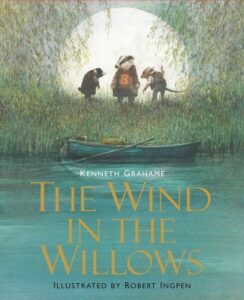
Book Summary
The Wind in the Willows is a wonderful book written by Kenneth Grahame. It tells the exciting and adventurous story of four animal friends who live in the English countryside. They have lots of fun and go on amazing journeys together!
This book is full of excitement and friendship. The main characters are Mole, Rat, Toad, and Badger. Mole is a little animal who loves exploring and making new friends. Rat is a kind and wise animal who loves boating and taking care of his friends. Toad is a funny and mischievous animal who always gets into trouble. And Badger is a brave and strong animal who helps his friends when they need it.
In the book, you will read about their adventures, like going on a river trip, saving Toad from some naughty weasels, and even helping Toad get his fancy car back! They face challenges and learn important lessons about friendship and bravery along the way.
The Wind in the Willows is a classic book that has been loved by many people for a long time. It teaches us about the importance of friendship and being there for each other. The author, Kenneth Grahame, uses beautiful and descriptive language to make the story come alive in our imaginations. The book also has lovely illustrations that help us picture the characters and their exciting adventures.
Kenneth Grahame was a British writer who lived from 1859 to 1932. He loved nature and spent a lot of time exploring the countryside, which inspired him to write The Wind in the Willows. Grahame’s book became very popular and is still loved by readers of all ages today. He also wrote other stories and poems, but The Wind in the Willows is his most famous work.
“The Wind in the Willows” is a classic children’s novel written by Kenneth Grahame, first published in 1908. The story is set in a pastoral version of Edwardian England and revolves around four anthropomorphic animal characters – Mole, Rat, Toad, and Badger. The book is a blend of adventure, morality, and mysticism, and it has been cherished by readers of all ages for over a century.
“The Wind in the Willows” is a charming and timeless tale that explores themes of friendship, adventure, and the love of home. The story begins with Mole, who leaves his spring-cleaning to explore the world outside his burrow. He soon befriends the water-loving Rat, and together they embark on various adventures, including dealing with the reckless Toad and the wise, solitary Badger.
The narrative is filled with vivid descriptions of the English countryside, and Grahame’s love for nature shines through every page. The characters are endearing, each with their unique quirks and personalities. Toad’s reckless enthusiasm, Rat’s love for the river, Mole’s curiosity, and Badger’s wisdom create a delightful mix of characters that readers can easily relate to.
The book is not just a simple tale of animal adventures. It also delves into deeper themes like the importance of home, the value of true friendship, and the struggle between the peaceful rural life and the encroaching industrialization. The story’s charm lies in its ability to appeal to both children and adults, with its simple yet profound narrative.
“The Wind in the Willows” is a multi-layered work that can be read as a simple children’s story or a profound social commentary. The anthropomorphic characters represent different aspects of human nature and society. For instance, Toad’s reckless behavior and obsession with motor cars symbolize the reckless pursuit of modernity and the dangers it poses to the peaceful rural life.
The novel also explores the theme of home and belonging. Mole’s journey from his comfortable burrow to the wide world outside mirrors the human journey of self-discovery and the longing for a sense of belonging. The river, where Rat lives, symbolizes life’s flow and continuity, while the Wild Wood, where Badger resides, represents the unknown and the fear of change.
The mystical element in the story, particularly the chapter “The Piper at the Gates of Dawn,” adds a spiritual dimension to the narrative. It suggests a deep reverence for nature and the divine presence in all living things.
Kenneth Grahame was born in Edinburgh, Scotland, in 1859. After the death of his mother and the mental breakdown of his father, Grahame and his siblings were sent to live with their grandmother in Berkshire, England. His experiences in the idyllic countryside greatly influenced his writing, particularly “The Wind in the Willows.”
Grahame began his career in the Bank of England, where he worked for over 30 years. However, his heart was always in writing. He first gained recognition for his collections of short stories, such as “The Golden Age” and “Dream Days,” which also feature anthropomorphic animal characters.
“The Wind in the Willows” was initially rejected by publishers, but it eventually became one of the most beloved children’s books of all time. Grahame retired from his banking career shortly after its publication and spent the rest of his life as a country gentleman. He passed away in 1932, leaving behind a legacy of timeless literature.
Don Quixote by Miguel de Cervantes
Miguel de Cervantes
Read Now →